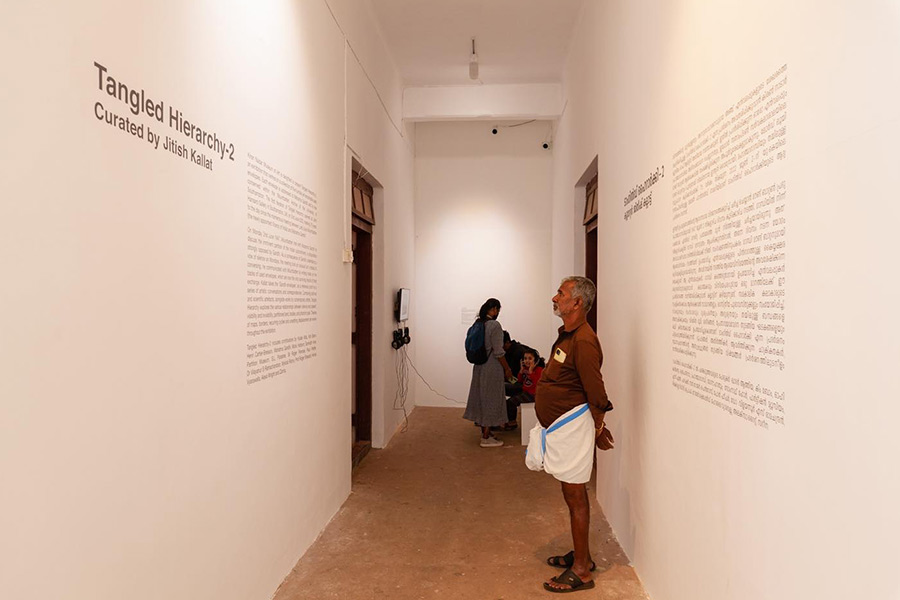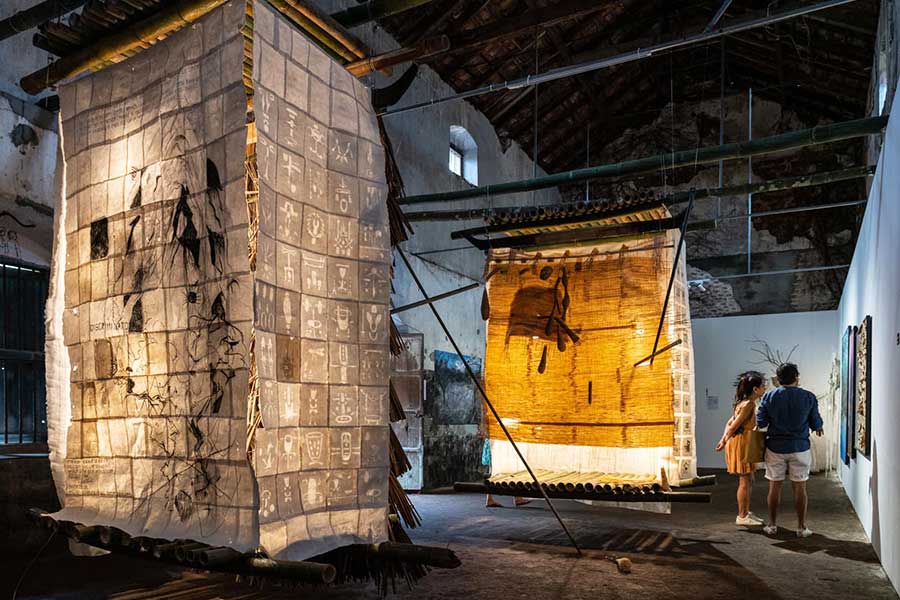The first dribbles of information about the sixth Kochi-Muziris Biennale, one of the freshest festivals of contemporary art anywhere, are leaking out. It will open this December and run until April 2025, and Kerala is giving a Rs 5 crore dollop of kickstart funding. The next major announcement should be the name of the guest curator, who will create a theme to connect the artists and determine the festival’s overall character.
What I suggest is you don’t wait for that; just nail a hotel booking now. If the sixth edition is as interesting as past ones – I’ve attended three of them – it should be well worth the trip down south.
Back in 2011, the founding idea for the biennale was to push the very concept of the art festival into a much freer space. It had no existing infrastructure, no great dollops of funding, nowhere to show art. Never mind such practical trivia. What it did have was the Kerala government’s department of cultural affairs commitment to stage it. They encouraged two Malayali artists, Bose Krishnamachari (now president and director) and Riyas Komu, to realise their dreams.
With government, private and local business support they secured a few of Kochi’s forgotten buildings, especially waterside warehouses, ideal for displaying art. These they filled with edgy installations and projects by artists who would become the show’s spokespeople and supporters. As the show ran for several months over winter 2011-12, there was an absence of the usual art show frenzy at art fairs in other parts of the world; Kochi Biennale reflected Kerala’s relaxed pace and intellectual inquiry. Unhampered by international gallery pressure for big-ticket artists and A-list collectors, it showcased artists from Kerala and across India and the world, each invited for their interesting art rather than their price point.
A very special art show was born, like no other: fresh, dynamic, original, often witty, sometimes delightfully whimsical. Free spirit was its signature – the ‘Muziris’ part of its title refers to Kochi’s mythical past, which was absorbed into its rich cosmopolitan history as an international port and is part of today’s vibrant Kochi.
It fell to Mumbai artist Jitish Kallat to ensure the show lived up to its aims and kept that initial spirit alive. Appointed curator and artistic director for the second Kochi Biennale (and then an ongoing Trustee), he had just 11 months to produce the entire show, with little assistance. “It was a very nascent organisation,” he told me last January, during the fifth edition. “I had to elevate the status of the biennale and also stabilise it. I hit the ground running. I invited 42 of the 90 participating artists. The show had a hundred projects across eight venues. It was team work, I lived in Kochi for nine months.”
The Kochi-Muziris Biennale weathered Covid and other delays to emerge for its fifth edition in 2022-23. Kallat was pleased. “It’s got roots, and is widely known. The curator has more time to travel than I did – to consider.” Indeed, the official show now fills three buildings and related shows and programmes fill another dozen or so. For instance, in the fifth edition, Riyas Komu, a Biennale co-founder, directed ‘Sea – A Boiling Vessel’, which was shown in Kashi Hallegua House, a former Jewish marriage hall and mansion. And in a new Invitations Programme, Kallat’s thought-provoking ‘Covering Letter’ and ‘Tangled Hierarchy II’ were displayed at TKM Warehouse by the partnership of Kiran Nadar Museum of Art and John Hansard Gallery, Southampton, UK.

‘Tangled Hierarchy II’ was displayed at TKM Warehouse
Kochi-Muziris Biennale/Facebook“The beauty of this artist-driven Biennale project,” Kallat says, “is it’s playing on the edge of what’s possible. That adventure is fundamental to its energy.”
Each edition has its own invited curator. For the fifth edition, it was Indian-born Singaporean artist Shubigi Rao. Her theme, ‘In our veins flow ink and fire’, reflected the world’s tough times in an optimistic way by referring to the ability of humans and communities to flourish through ‘dire situations… the power of storytelling… optimism in practice… especially in regional or local contexts’. She wanted that Biennale, emerging out of Covid, to embody ‘the joy of experiencing practices of divergent sensibilities, under conditions both joyful and grim’.
The huge metaphysical painting in rich bright colours by Smitha G S, a Biennale commission, confronted these ideas full on. A self-taught artist from Kozhikode (Calicut) in Kerala, Smitha G S recreates her own life through landscapes populated by disturbing isolated scenes that bring to mind Pieter Bruegel the Elder’s apocalyptic painting The Triumph of Death painted in 1562. Swathed in a mauve Calicut-woven cotton sari, she talked to me quietly but firmly about her painting while her eyes smile through turquoise-rimmed spectacles.

Smitha G S’s monumental commission addressed not just our times but a fundamental human condition
During lockdown, she said, cut off from the world outside, she was depressed – her picture’s deep magenta red refers to her tension and depression. Yet making the painting freed her. “It was a source of release,” she said. “I forgot my family worries while working on it.” She painted directly onto the canvas, with no preparatory drawings or composition notes. “I always see with great colour intensity. First, I put the olive green, then the magenta red.” Then she added small insects, creatures and, for the first time, humans. Her green is used symbolically. “Although the green is for the forest,” she explained, “there are no green leaves in my painting. Live creatures are in green because when I was a child, my father wove toys of coconut leaves in the traditional way.”
But this is not a picture of happy childhood nostalgia. While she painted it, her father was ill and by adding these toys she hoped he would recover; he did. Just as important, the isolated stories in the painting connect as a fierce critique of society, what she calls “so many malpractices in life”. She told me she deplores the promotors of dangerous superstition and blind belief. Looking patiently across her painting, I spotted the astrologers’ board, animal sacrifice, black magic, last rights performed as empty ritual by a son beside the river. Looking more closely, I found a pala tree used in Kerala to exorcise the devil from women, masks worn by a couple who cannot be themselves in marriage, copulation with a skeleton to denote a mechanical loveless marriage. Dotted about the painting were instruments of self-harm, such as rods drilled through a man’s cheeks.

Artist Smitha G S
Smitha G S’s monumental commission addressed not just our times but a fundamental human condition that uses ritual to appease the fear of chaos. Yet, she told me that she freed herself from all of this before she made the painting; she does not even need to imagine the simple death rituals that console most people’s fear of death.
This is how she explained her own freedom: “When you think you have made a mistake, you do a self-penance seeking forgiveness. This is about fear and guilt. I realised I’d done no wrong. So, I spread goodness all around. I’m passionate about it. All these things I paint do not exist – they are imaginary.” This was her message, playing directly into Shubigi Rao’s Biennale theme of storytelling and optimism in dire times.’
For the approaching 2024-25 edition of the Kochi-Muziris Biennale, we wait to know who is the guest curator, and their theme. Then, in December we shall see how artists interpret it in our acutely troubled yet simultaneously progressive times.
Louise Nicholson is a British art historian, journalist and writer who has focused her studies on India since 1978 and brings the curious to India. She has written 27 books, and writes a monthly wellness blog to inspire slow travel in India.






